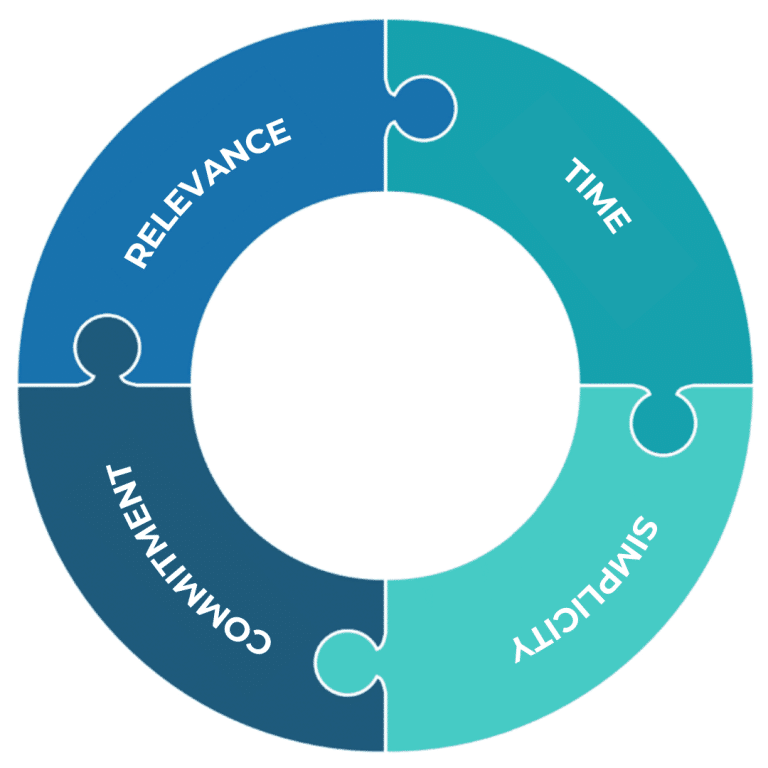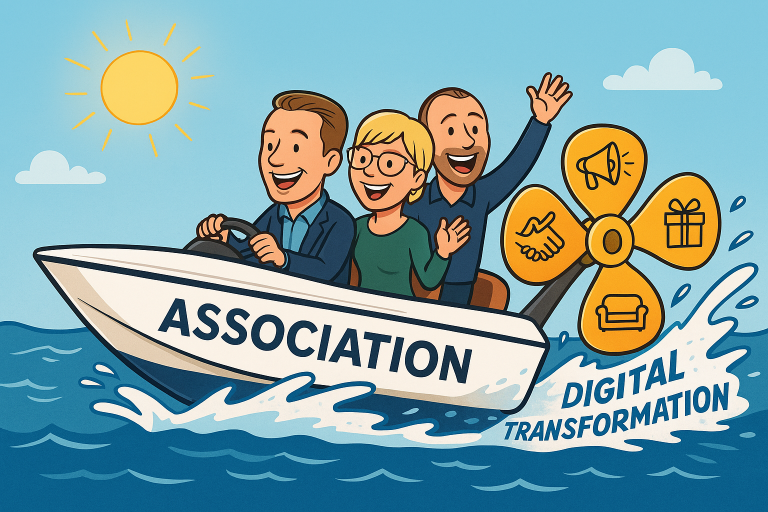Digital services and the changing role of associations [4/5]
Modern associations facilitate knowledge sharing and connection among members. They do this year-round, not just during events. But how do associations do this practically? The “Digital Service & Communication Model for Associations” shows what digital resources you need to grow digitally. Mathijs and Dennis explain this and meanwhile give numerous tips for a thriving digital association.
By: Mathijs Vleeming & Dennis van Aalst, Yard | Digital Agency
Also read:
- Part 1 on the “Digital Service & Communication Model for Associations”.
- Part 2 on the value of knowledge sharing within an association.
- Part 3 on the changing way of connecting of members.
(click on image to enlarge)

Continuous member connection and knowledge sharing
In an earlier blog, we discussed that it is crucial for associations to share knowledge. Facilitating associations share not only validated knowledge from experts, but also user-generated knowledge. Members perceive great value in being able to exchange this knowledge under the wings of their association. In addition, facilitating associations are characterized by facilitating connection throughout the year, not just during events. But how do facilitating associations do this practically?
Own community platform
In practice, we see facilitating associations opting for an online community platform as the most efficient way to facilitate connection and knowledge sharing. The benefits of such an in-house platform are often greater than associations initially think.
Why choose your own community platform
- A central, secure, and trusted online environment
- 365 days of engagement; integrate learning & events
- Create a knowledge hub; safeguard knowledge and make it easily accessible
- Connect and activate people based on expertise and interests
- Use data for personalization & gamification
- More efficient activities, processes, and support
- Greater reach, inclusivity, and access to information
- Potential diversity in revenue streams
- Stay informed about member concerns; quick feedback loops
- Increased engagement, co-creation, and a sense of community
We elaborate on this further below.
1. A central, secure, and trusted online environment
A community platform brings members together online in a central, secure, and trusted environment under your brand. This allows you to directly connect member expertise and knowledge within your niche.
Many organizations use a variety of separate digital tools for their website, events, newsletters, surveys, knowledge bases, and more. These organizations communicate with their members through each of these tools separately. Additionally, members often have to log in to each platform individually. As a result, the digital resources available are highly fragmented.
Digital services: One central platform
The facilitating organization takes digital services a step further by ensuring that members only need to log in once to access a central platform. From this platform, they can utilize a variety of online tools, such as community platforms, knowledge bases, and e-learning environments.
Increasingly, organizations are also offering a mobile app, giving members access to relevant knowledge and their trusted network anytime, anywhere. This concept is often referred to as “the association in your pocket.”
These digitally mature organizations also provide their users with a GDPR-compliant environment through their own platform, which is an important added benefit.

2. 365 Days of engagement: Integrate learning & events
With your own community platform, you can connect members year-round, anytime, and anywhere. Additionally, it offers the ability to integrate education (e-learning) and events, ensuring that interaction and engagement continue organically on an ongoing basis.
Integrating events
Setting up an online event via Zoom and promoting it through social media channels or mailing lists is straightforward, and there are plenty of apps and platforms available for virtual events. So, why use an online community platform for this? An online community platform allows you to connect event participants in one central place, both during and between events. This continuous connection helps members consistently experience the value of the organization, which, in the long run, increases member retention.

How to use an online community for events
- Engage Participants Before and After the Event:
Allow participants to submit questions and topics they’d like to see addressed before the event through polls and Q&A features. Use any unanswered questions during the event to spark ongoing conversations in your community. This creates a knowledge hub related to the session, where participants can discuss ideas, ask follow-up questions, and access recordings and presentation materials in one place.
- Involve Event Speakers and Experts in Online Discussions:
Encourage speakers to seek input for their sessions before the event and to start a follow-up Q&A conversation online immediately afterward. This keeps the dialogue going and deepens the engagement with the content.
- Keep Participants Engaged Between Events:
Host “Ask Me Anything” (AMA) sessions and ensure that experts and speakers are present in the community to answer questions continuously. You can also invite other experts in your community to help speakers identify questions and keep the conversation lively.
- Attract More Participants for Your Events:
Promote events more organically by showcasing who has already registered and leveraging word-of-mouth from past participants. Use content from previous events to create serious FOMO (Fear of Missing Out) and drive interest in future events.
- Offer High-Quality Sponsor Options Year-Round:
With a community, you can experiment with various new revenue strategies. Examples include sponsored ads, blogs, news posts, discussion posts, sponsored events and whitepapers, sponsors paying for community access, or even a sponsor funding the community platform itself. This provides value to sponsors throughout the year, not just during events.
3. Create a knowledge hub: safeguard knowledge and make it accessible
A community platform enhances your organization’s information assests by creating an online knowledge center for your sector, and by extension, for the broader community. You can share presentations, reports, and background information in a searchable library.
Additionally, offer on-demand access to recorded sessions from past events, either free or paid. This not only extends the reach of these events but also generates organic promotion for future ones. In this way, you create a knowledge hub that is integrated with live events and continues to provide value long after the events have concluded.
4. Connect and activate people based on expertise and interests
A community platform makes it easy to identify common interests and themes that serve as “connectors” for members to find one another. Engage your members in the topics they care most about, whether these relate to expertise (themes), projects (working groups), location (regional groups and profile searchability), circumstances, specific needs, and more.
By leveraging these shared expertise and interests, your organization can quickly see what knowledge members are seeking and sharing in your online community. This insight allows you to tailor communication about news, events, documents, and education to what is most relevant to your members.
Moreover, an online community platform empowers your members to initiate and organize their own events within the community, post challenges and potential solutions, start relevant discussions, and create specialized subcommunities. This fosters a dialogue with and among your members, rather than just disseminating information from the top down as in a traditional organization.
5. Use data for personalization & gamification
To offer relevant communication and processes, personalization is key, and for that, it’s crucial to use data. Members provide a lot of information, but often organizations don’t store this data centrally, leading to limited insight into their members.
By offering a central online experience, it’s easy to collect this data in the background and gain insights into what members are doing. What services are they using? What are their areas of interest? Which e-learnings have they completed? Which articles have they read? Which events have they attented? This rich data source allows facilitating organizations to personalize information and services.
You can also encourage more contributions based on how active members are. Motive them to increase their status within the community by making their contributions visible. For example, you can use leaderboards to display activity levels, a feature commonly known as gamification.

6. More efficient activities, processes, and support
Your community platform holds a wealth of data about your members’ interests, which can be used to tailer your processes and communication effectively. Facilitating organizations often have more advanced automation in their processes, providing customized services based on member profiles and needs. Communication can be personalized according to members’ interests and expertise, and members can specify how often they wish to receive certain types of information.
Much of this information delivery can be automated, making communication more relevant while relieving the organizational staff of their workload. Additionally, the platform enables members to ask and answer questions amongst themselves, reducing the need for staff to handle every query. While monitoring is necessary, this setup allows for more efficient support and enhances the overall experience for your members.
7. Greater reach, inclusivity, and access to information
An online community platform fosters inclusivity and diversity by allowing more members to participate in discussions and access the information within your organization. It provides an alternative for those who cannot or prefer not to attend in-person events, regardless of time and location.
Additionally, the platform can be made accessible to individuals with visual impairments or offered in multiple languages. As the owner of the platform, you can ensure that the online spaces feel inclusive and welcoming to everyone who joins.
You can also offer regional or even global membership programs outside of your organization’s operating hours and address cultural differences by creating groups for specific member types of geographic regions. This approach ensures that all community members derive the most value from their interactions.
8. Potential revenue diversity
Online community platforms can facilitate new membership models and revenue sources. Consider the following options:
- Different membership models with different fees that provide access to specific information and services
- One-time access to specific information. For example, charge money to view recordings of events
- Tickets for events
- Integrated e-learning and certification modules
- Advertisements on your platform
- Sponsored content, groups or events
- Donations
If you want to generate revenue from your online community, you need to put the shared mission first. Members are more willing to pay for access to information, events or groups if they know what the money is being used for. They need to feel that their payments are contributing to your association’s mission. For example, let them know that the money will be used for important projects or expansion of services.
9. Know what’s going on among members; quick feedback loops
If you embrace the community mindset, then you have a good understanding of what is going on among your members. This allows you as an association to better respond to the needs of your members. Online communities create, as it were, super-fast feedback loops with your members. Because you are closer to the action, you can experiment and innovate more easily. Moreover, as an association you can more easily determine the course of your association in changing circumstances, for example in times of disruption.
10. More involvement, co-creation and ‘association feeling’
Through an online platform, you as an association can easily assume a facilitating role and collaborate with your members. A community approach in which you, as an association, do not do everything yourself makes scaling up possible. This is because you tap into the power of the network and increase the capacity to learn and share knowledge. This increases the potential impact of your organization.
The gold of an association: your members
In short, you have real gold in your hands as an association: namely, your members. In fact, you have an enormous target group at your disposal to which you have unlimited access. Many corporations are trying to build (online) communities as they see the need and potential (business) benefits they bring in terms of client engagement, retention, and reach. You could argue that when they take this approach, they are acting like associations. You already have access to your clients and have already built an (offline) community. It is such a shame that a very large number of associations do not make sufficient use of this.
Threshold to start
We see that some associations find the threshold high to start an online community and increase the associated sense of community. Our advice is: start small and simple. Building a true community with a high sense of belonging is a higher goal. Start simple, for example by bringing question and answer or supply and demand together on an online “marketplace”.
The successful platform “Een Tweetje” of the Dutch Soccer Associations (KNVB) is based on board members of soccer clubs asking and answering questions. This is very relevant for them as they are facing very similar challenges, but often are not in touch with each other. But their sense of community is probably not that high.
Platform model
Bringing together supply and demand is also called a “platform model” or “digital economy”. A well-known example in The Netherlands is the NVM, the Dutch association of real estate agents, which started “house-finder platform” Funda. Funda has enormous added value for its members. The association gets a lot of data from the platform, for example about market developments. The NVM then uses this in turn for advocacy in The Hague.
Another great example is the platform of CBM, the trade association for furniture and interior designers. They have an internal marketplace where supply and demand in materials and labor hours come together. You can think of this as an additional digital service for members.
So think carefully about what you leave to the market and what you develop in-house as an association. Often associations underestimate the potential they have to set up something like this. Start with the basics: bring people together who are looking for specific information, and come to get and bring something. If you set that up in an effective way, you offer a lot of added value as an association!

Case: Matching supply and demand at the LHV
We developed the Praktijkmatch for the Landelijke Huisartsen Vereniging (LHV). This is another digital platform that brings supply and demand together. On the private platform, GPs offer their practices for takeover and interested parties can respond. By developing its own platform for this purpose, the LHV keeps all data under its own control and creates a safe environment. Read more about the Practice Match in the case about the LHV.

Next time: Organization and the changing role of associations.
The modern association focuses on facilitating members. This requires a different organization of your association. So what should you think about?
About the Authors
Mathijs believes that associations can increase their impact by connecting their members throughout the year and facilitating knowledge sharing. He draws on his 20 years of experience in the “heart of the world of professional community builders,” specifically in the international meetings industry for association conferences and events at the International Congress and Convention Association, where he was Director of Marketing.
For over 3 years, Mathijs has worked as a community strategist and consultant. In this role, he helps associations and other organizations create online community strategies. He does this at Yard Digital Agency, the market leader in digital communication and community solutions for associations and public organizations in the Netherlands.
Mathijs wrote an eBook with input from associations and community leaders titled “The Association Community Compendium: How to Harness the Collective Power of Your Members.” He is also a board member of the Community Consultants Collective and a contributing expert for Association Meetings International.


Dennis believes in the power of digital. With passion, he and his motivated colleagues support social organizations in achieving digital impact. Dennis is an experienced online strategist within the association sector. [Can you provide evidence of this and share more about your experience with associations?] Due to his in-depth knowledge of associations, he serves as a sparring partner and advisor for associations looking to grow digitally.
Together with the KNVB and Yard | Digital Agency, Dennis won the Dutch Interactive Award (DIA) 2021 in the category of communities. They won this award for the platform Eén tweetje, for which Dennis developed the strategy in collaboration with the KNVB [is this correct?]. “The community represents a game changer in the way the KNVB communicates,” according to the jury. “A shift from top-down to peer-to-peer.”
Additionally, Dennis is a trainer in digital communities at De Nederlandse Associatie (DNA). Through open and in-company workshops, he helps industry and professional associations discover the value of an online community. He also guides them in launching an online community and fostering interaction and engagement within the community.

Watch: Case Study TVVL
TVVL is the largest association of professionals in installation technology. How does this association use digital possibilities to connect its members and exchange knowledge? John Lens, Director of TVVL, talks about it with Mathijs Vleeming and Dennis van Aalst.
Also read

What 4 factors make an online community successful?

How can your association stay relevant in a digital world?

